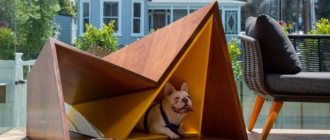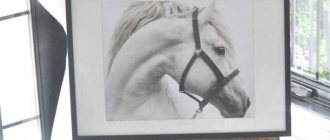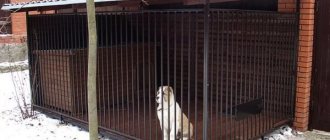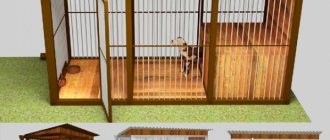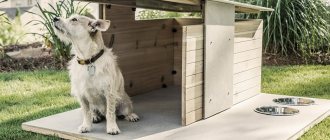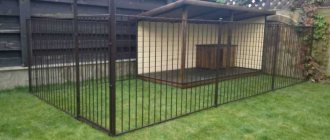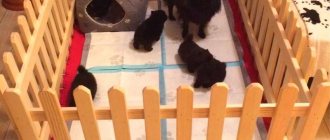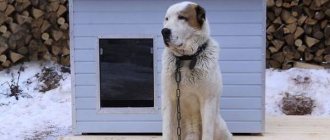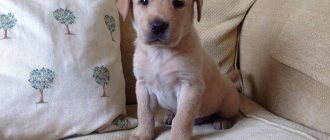The East European Shepherd is a large breed of dog, so it is often used as a guard on the site. The best living conditions in this case are housing in the form of a booth installed in an outdoor enclosure.
This type of booth can be made for a shepherd
Drawings and dimensions
In order for the construction to be successful, it is important to correctly calculate the size of the booth for the East European Shepherd, as well as the area of the enclosure. To do this, you must first measure the animal - body length from nose to tail, height at the withers. 15 cm is added to these values - this is how you will find out the appropriate size of the booth for VEO. The width of the dog's chest will be needed to calculate the width of the entrance hole - add 5-8 cm to the resulting figure. To find out the height of the opening, subtract 10 cm from the height at the withers.
Often, at the time of construction, the dog is still small and the owners do not know what size booth it will need. Then it is better to take the advice of breeders and take standard sizes as a basis:
- length - about 115-120 cm;
- width - 65-85 cm;
- booth height - 80-90 cm;
- hole size - 35x55 cm.
Booth parameters for the East European Shepherd
This kennel size should be suitable for an adult shepherd.
The area of the enclosure should not be less than 4 square meters, otherwise it will negatively affect the health of the animal. The enclosure can be either closed or without a roof. Small buildings usually have one or two blank walls for protection from wind.
IMPORTANT: If you want to provide your dog with more space to move, it is better to build an enclosure with a size of 8 square meters or more. Sometimes an option is used with a fence that covers the perimeter of the site with a corridor - this way the shepherd dog can make up for the lack of movement and control the entire territory.
DIY enclosure for an East European Shepherd
For construction, you can take a ready-made project, or develop a construction scheme yourself.
Drawing with dimensions of the enclosure for Veo
Once the drawing is ready, you can start working:
- If the enclosure for VEO is solid and heavy, first pour a strip foundation; its surface should protrude 20-30 cm above ground level. This will also help protect the building from flooding during rain.
- If the fence is light in weight, make a foundation of wooden beams and edged boards. For waterproofing, it should be covered with a layer of roofing material.
- Supports with a height of 1.8-2 m are installed along the perimeter. On a concrete foundation, you can use brick; on a wooden foundation, only metal supports under the mesh.
- A fence is attached to the supports - strong metal rods welded into a lattice are best suited. For light fencing, a metal mesh with a mesh size of 5 cm is used.
Option for an enclosure without a foundation
If the enclosure is large, you can do without a foundation, making only a base for the booth. The door to the enclosure should only open inward, and also have reliable locks on both sides - this will be needed when training the dog in the enclosure.
DIY booth for VEO
The most convenient for a dog and appropriate in the winter season would be a kennel with a vestibule. In such a structure, the shepherd will be able to lie down stretched out, and during cold weather he will curl up in the main compartment, keeping warm. To build a booth with your own hands, follow the following steps step by step:
- A base 15 cm high is knocked together from wooden blocks and clapboard.
- A frame for the walls is installed from vertical beams; self-tapping screws and metal corners are used for fastening.
- The frame is covered with clapboard or plywood.
- A manhole and an internal partition are created to separate the vestibule. To close the hole, a curtain made of plastic or tarpaulin is attached.
- A roof frame is constructed from beams - it is better if the roof has a slope of 15 degrees.
- The roof is installed; it is better to attach it to the door hinges - this design will make cleaning easier.
- The roof covering is being laid. It is better not to use hard materials - metal, tiles, they will make a lot of noise when it rains.
Veo booth with vestibule
To insulate a doghouse, you need an additional layer - polystyrene foam, mineral wool, or other thermal insulation filler will do. They cover the walls from the outside, then the house is once again covered with clapboard. At the final stage, the outside walls of the booth are treated with protective moisture-resistant impregnations and covered with paint.
Installation Precautions
The following precautions must be observed during installation:
- do not place the structure where there is a risk of mechanical damage. For example, snow or ice blocks falling from the roofs of houses;
- do not place the booth in lowlands, in places subject to flooding;
- Once every six months you need to check the condition of the frame supports of the booth. Damaged elements must be replaced in a timely manner;
- Don’t forget to clear snow from the roof in a timely manner. Although if the layer of snow does not exceed 2 cm, then it can be left. This natural coating serves as additional thermal insulation;
- Hinges and other metal parts should be lubricated regularly.
With proper care and constant supervision, the booth will last about 10 years.
Choosing the size of a dog house
To choose a good booth for your dog, you need to accurately determine its size. The dimensions depend not so much on how much space there is on your property to accommodate a dog, but also on the breed and size of a particular dog. Obviously, a booth that is too cramped is unlikely to please your four-legged friend. If it is inconvenient for him to enter it, and there is too little space to fit in there, the dog may abandon the booth altogether.
The other extreme is a booth that is too spacious. An excessively large area may deter some dogs. But the most important thing is that the dog will be cold in a kennel that is too spacious. Since the dog warms its home with the heat of its own body, the size of the booth should be optimal - not too small, but not too large. Many owners with the best intentions try to order a booth as spacious as possible, but we always warn against such gigantomania. The dog will be much more comfortable if the booth is just right for it.
Design options
They are selected depending on several important factors:
- number of dogs - for a couple or a female with puppies, of course, more space will be required than for one watchdog;
- breeds - herding, mountain dogs are much less sensitive to cold than smooth-haired and short-haired dogs, so the degree of insulation of the building will vary greatly;
- conditions for keeping the pet. If he freely “walks around the territory”, then the house may be smaller than for a dog sitting on a chain;
- weather conditions. In a rainy climate, a security guard will need a roof over his head in any case, even if there is no severe cold. For very hot climates, lattice or canopy-style dwellings are suitable.
In addition, booths are distinguished by the materials used. Most often they are built from wood and wood-based materials, including frames. However, in some cases, more capital structures are possible - for example, made of brick or gas blocks.
Structurally, “houses” are distinguished as:
- a canopy with more or less fenced sides;
- A-shaped (“hut”);
- traditional rectangular shape with a gable or flat roof;
- buildings with more complex geometry.
You can supplement the dog house with your own hands with a small platform - a terrace - with or without a canopy, for the dog to rest outside the covered building. Feeding and food storage areas are often added.
Necessity of a dog kennel
Many owners of German Shepherds get their pets to guard their garden. This involves keeping the dog in the yard or enclosure all year round. In order for the animal to feel comfortable, it needs a place where the dog can rest and hide from the cold, precipitation or scorching summer sun , and a warm and cozy kennel is best suited for this.
In addition, the presence of a kennel on the site will relieve the owner of a shepherd from the need to let the dog out into the yard, and when it has walked, take it into the house. The pet decides for itself when it should leave the kennel and when it should come back.
This gives the shepherd self-confidence and has a beneficial effect on the psyche and protective qualities of the animal.
In addition, a good-quality and beautiful dog house, made according to an original design, can also become an excellent decoration for the yard.
Types and how to choose the optimal project
The owner of the animal has the right to independently choose the design and appearance of the kennel for his pet. Manufacturers offer booths of a wide variety of shapes, often in fantasy shapes. For example, you can buy a booth in the shape of a mansion or even a royal palace. Another popular solution is to style the kennel to match the design of the dog owner’s home. Many shepherd owners believe that such a booth looks very original and interesting.
However, when choosing a suitable design project, you must first remember that the doghouse must first and foremost be comfortable and functional. If it consists of several parts or has an overly complex design, then the animal may not feel very comfortable in such a “house”. And such a kennel can take up a lot of space. This may be appropriate in a large country mansion, but is not very suitable for the small yard of an ordinary private house.
What types of dog kennels are there and how to choose the most suitable one for your pet? Below are 4 options with photos and brief descriptions.
Single-pitch
The roof in such booths consists of a horizontal surface set at a slight angle. This design allows rainwater to flow down, but at the same time gives the shepherd the opportunity to use the roof as an observation point, from where it is very convenient for the pet to monitor what is happening on the site.
Gable
Two halves of such a roof, placed end-to-end, form an acute angle. This ensures faster water drainage and melted snow removal, which increases the wear resistance of the kennel and extends its service life.
With vestibule
Such a booth retains heat better due to an additional compartment that prevents cold air or precipitation from entering the room.
With an aviary
A kennel equipped with an enclosure gives the shepherd greater freedom of movement. In addition, this design prevents the animal from leaving the territory it protects without permission.
If you are going to breed German shepherds, then choose a booth equipped with an enclosure. In it, the bitch and her puppies will feel comfortable and at the same time be completely safe.
The same design is also suitable for keeping several dogs. You also need to take into account the climatic characteristics of your region. For example, for areas where it is often too cold or windy. In this case, a booth with a vestibule would be an ideal option. And if your region has high humidity and often rains, then a kennel with a gable roof would be the best choice.
Video description
The following video will tell you in detail how you can make an enclosure for a shepherd:
In order for the dog to quickly get used to its new housing, it must be fed only inside the enclosure. While the animal is eating, it needs to be locked, and then opened and released outside, but not immediately, but after ten minutes. Every day this period of time will have to be extended. A large bone will help lure your pet inside. Over time, the dog will get used to the fact that during the day it needs to be in the enclosure, and in the evening it is allowed to walk around the yard.
If desired, you can train your dog to relieve itself in a strictly designated place. To do this, they make a toilet out of a basin or foot bath for her. Place it in the farthest corner from the feeder, push the dishes into the floor and fill them to the top with sand. While the dog is being accustomed to the enclosure, the toilet is temporarily covered with plywood, giving the pet the opportunity to relieve itself where it wants. When he gets used to his new home, the dog is released into the wild.
Ready-made standard project Source remstroidomufa.ru
While she is walking, a fresh pile of droppings is buried in the sand of the toilet, and the rest of the area is thoroughly cleaned. Then the dog is released into the enclosure. This method of training works flawlessly: animals always mark the latrine with excrement. Therefore, the pet will defecate where the owner buried its fresh excrement. Sand is needed only to satisfy the instinct to bury droppings. It will need to be changed periodically. This is easier to do than washing the floor of the enclosure every time.
Construction requirements
A kennel for a German Shepherd should be comfortable and cozy for your pet. The dog should not live in a box that is too cramped. But a “house” that is too spacious is also not suitable for her. The length of the dog kennel should be such that the shepherd can stretch out to his full height in it. But, given that the booth is heated in the cold season solely by the body heat of the pet itself, it is not recommended to make it too large.
Indeed, in this case it will be much more difficult to maintain the optimal temperature regime for the animal in the kennel. The following average kennel sizes are considered suitable for a German Shepherd:
- Length: from 120 to 125 cm. Moreover, if a vestibule is provided, then you will need to add another 20 or 30 cm to the length of the booth.
- Width: from 65 to 70 cm.
- Height: from 90 to 100 cm.
- Manhole: height - 60 cm, width - 40 cm.
The bottom of the booth should be slightly raised above ground level. This will make your shepherd’s “home” warmer and also more durable. A kennel installed directly on the ground will be more exposed to moisture. After all, all the water flowing from the roof will collect below, and this does not help extend its service life. Particular attention should be paid to the quality of the materials from which the booth will be made. They should not be flammable, nor resistant to moisture or temperature changes.
It is necessary that all materials are completely safe for the animal and, if possible, natural.
Manufacturing stages
First, a place is prepared for the construction of an enclosure. It needs to be cleared and sloped towards the facade. If the floor is not covered with boards later, experts recommend covering it with fine-grained pebbles (this will prevent the dog from injuring its paws). But first a metal mesh must be laid to a depth of one meter. She will not allow the dog to dig.
The frame of the future structure is assembled from metal pipes. They are connected to each other by welding. First you need to make a drawing of an enclosure for a German shepherd, taking into account all the requirements listed above. A grille is made from pipes for the façade. The dimensions between the slats should not exceed 10 cm.
Housing for a pet made of metal pipes Source yandex.ru
All metal elements are carefully primed and then covered with paint materials. Powder-coated pipes cannot be used for the designated purposes; galvanized products cannot be used.
To attach the boards, you must first make a hole, and only then attach them to the frame using stainless steel screws. If you do not make preliminary holes and immediately begin installing the boards using fasteners, the wood may burst or crack. Moisture that gets inside such a defect will trigger the onset of the rotting process.
When building walls, it is important to ensure that the first board at the base does not come into contact with the floor. To construct the roof, a wooden sheathing is made, and the roofing material is already attached to it.
Aviary with a wooden booth inside Source tugov.segopaq.ru.net
Dog measurement
To ensure that the kennel fits the dog perfectly in size, it is recommended to develop an individual design design taking into account the size of the pet. To do this, you need to make the following measurements:
- Body length. The distance is measured from the tip of the shepherd's nose to the base of its tail. Add 15 cm to this figure and you will find out what the ideal length of the booth for a pet should be.
- Overall growth. You need to measure the height of the animal from the top of the head to the floor. By adding 15 cm to the resulting number, you will find out what height the booth for your shepherd needs.
- Height at withers. Measured vertically from the highest point at the withers to the floor. Subtracting 5-10 cm from the resulting figure, you will get the ideal size of the hole.
- Chest width. Measure the distance between the shoulder-scapular joints of your pet, and add 5-10 cm to the resulting number. This will be the size of the width of the hole.
You need to take measurements of your pet in a calm environment, after placing the animal on a flat, hard surface and fixing it in the exhibition stand.
Selecting a location
The dog house should be located near the house. After all, for a shepherd guarding a property, it is very important that from its place it can see the front door and people entering the house. It is important that the dog can observe what is happening in the yard. Near the kennel there should be trees with spreading crowns or buildings that will provide shade and provide good protection from the wind.
The dog kennel should not be placed near farm animals or poultry.
After all, the noise and specific smells they produce will distract the shepherd from guarding the yard. For the same reason, you should not install a pet booth next to an outdoor toilet or garage. Also, do not place the shepherd’s “house” near the fence, as the pet may start barking at people passing along the street. The best place for a booth can be considered a small hill with a gentle slope. This arrangement of the kennel will improve the animal’s visibility and also significantly reduce the risk of flooding.
A Guide to Owning a Rottweiler German Shepherd
There are all kinds of mixed breed dogs in the world, each with their own unique and quirky names, but in this guide we'll focus on the German Shepherd Rottweiler hybrid.
These furry canines have many different names, including "Shepweiler", "Rottweiler Shepard" and even "Rotten Shepherd". Whatever you decide to call your new friend, it's important to know as much as possible about him before he joins the family. Like any dog, the German Shepherd Rottweiler mix has a list of specific needs and requirements for a happy and healthy life. Knowing your dog's background is also important and fun to learn, so we'll tell you where your Shepweiler came from and how this breed became so popular among dog lovers dogs and trainers. Looking at the parents of a mixed breed can tell you a lot about your four-legged friend and can give you a good idea of what to expect in terms of behavior, health and trainability.
Every dog deserves a loving home, so if you're considering getting a German Shepherd Rottweiler mix, it's important to make sure it's the right breed for you. Hopefully, after reading this helpful guide, you will have a better understanding of the breed and be able to decide whether it is right for you or not.
What is a German Shepherd Rottweiler Mix?
The result of crossing a purebred German Shepherd and a Rottweiler, the Shepweiler is a designer breed that was bred to combine the best elements of both of its parents. The German Shepherd and Rottweiler are two of the most desirable breeds in the world, and the combination of these two breeds has resulted in a very popular dog. Shepweiler Information:
- Life expectancy : approximately 10-13 years
- Average cost: £ 500-800
- Colors : Light to black, depending on parent breed
- Average weight : 35-52 kg
- Average height: 56-68cm
Mixing two very different dog breeds can often lead to a number of potential risks, but can also result in an amazing hybrid that suits all different types of people.
To better understand whether a Shepweiler is a good fit for you in terms of temperament and personality, it is important to look at its background and see what the dog's parents bring to the mix.
Origin of the Shepweiler
The Rottweiler is a type of working dog that was historically called a butcher's dog because it was often used to transport carts of meat to market.
Known for their strength, Rottweilers are medium-sized dogs with an average height of 56-69 cm and an average weight of 35-60 kg. These dogs are known for their rugged exterior, which has been cultivated over decades of their training as working dogs. When trains and automobiles eventually replaced the need for driving, the Rottweiler was no longer used to transport livestock, but it retained its powerful build and agility. In recent years they have been trained as guard, rescue and police dogs. The German Shepherd is much slimmer than the Rottweiler, weighing on average 22-40 kg, and reaching a height of 55-65 cm.
Belonging to the herding family, German Shepherds have been used as service dogs for decades and are known for their loyalty to their handler. German Shepherds are renowned not only for their iconic appearance, but also for their intelligence and trainability, which in recent years has led many of them to careers as guide dogs , military dogs and even active dogs. They are currently the second most popular dog breed in the world and have found homes with a wide variety of owners around the world.
Shepweiler temperament
As with any type of mixed breed, it can be difficult to accurately predict what a Shepweiler's temperament will be since we can only base it on the parent breeds.
The reputation of its parent breeds means that the Shepweiler's temperament is often subject to scrutiny. Both German Shepherds and Rottweilers were historically trained as guard dogs and were bred to be aggressive on command.
This has led to a number of misconceptions and is often misunderstood by many people. German Shepherds have a deep-rooted sense of protection that often leads to confrontation if they feel their home is under threat. This can be a problem in a family home if you do not train the dog properly. German Shepherds are very intelligent and their aggression can be controlled and chased, which is why they are often used as police and service dogs. Like their German cousins, Rottweilers are known to show aggression towards perceived intruders and other dogs, which has led to the development of them negative stereotypes in the media. There have been many cases of untrained Rottweilers attacking passers-by, often due to a lack of dedication from their owner.
Despite the negative stereotypes, it is important to remember that the aggression exhibited by these two parent breeds comes from a desire to protect and is easily controlled in the Sheepweiler with proper training and dedication.
Image source: https://www.pinterest.co.uk/pi.
Training German Shepherds and Rottweilers
The most amazing thing about Shepweilers is the very high level of intelligence that they have inherited from their parent breeds, which means that they learn very quickly and are easy to train. Because of their natural temperament and protective instinct, it is very important to get them socializing as soon as possible. You'll need to get your Shepweiler puppy used to being around strangers and other dogs, so it's a good idea to immerse them in social areas. Having a lot of visitors come into the house to introduce themselves will numb your puppy's urge to defend itself. The best type of training for any guard breed has been proven to be dogs is based on reward methods. Punishment methods are not recommended due to their naturally aggressive temperament, which can become stronger as the Shepweiler ages.
Shepweiler care
The level of care and rate at which your Shepweiler will shed depends on the more dominant parental genes.
If your puppy inherits the beautiful thick coat of a German Shepherd, he will require a lot more grooming and will need to be brushed a couple of times a week to keep his coat healthy. When shedding season arrives, you'll need to get the brush out even more often. If your Sheepweiler has a much shorter coat than your Rottweiler, then you're in luck and will need to brush him about once a week. It is still important to keep them well groomed to improve blood flow and get rid of dead skin or excess hair. If you share our love for all pets and are considering enrolling in a dog grooming course, book a visit or download our brochure to receive additional information. If you've already started your own business, find out how GroomArts can help your business. Image source: https://www.pinterest.co.uk/pi.
Shepweiler health
Like many other mixed breed dogs, the Shepweiler is susceptible to a number of potential health problems or inherited genetic problems.
In many cases, these problems begin to appear much later in a dog's life, so it is important to keep him active and healthy from an early age. There are a number of conditions that can develop in larger mixed breed dogs such as the Shepweiler. These include things like hip dysplasia, joint problems, skin allergies and eye diseases [Eileen AC1]. Regular health checks and a healthy, balanced diet are vital to keeping your dog healthy for the long term. Unfortunately, both Shepweiler parent breeds are prone to hip dysplasia and joint problems, meaning this can be a very serious problem for your canine friend Maintaining a healthy weight can help reduce the effects of these conditions, so if you decide to adopt a Shepweiler, make sure he gets plenty of exercise and eats a healthy diet.
Shepweiler physical activity requirements
Like both parent breeds, the Shepweiler is a very energetic and playful dog that loves to stay active.
It is important that your dog gets plenty of exercise so that he can use all his pent-up energy.
If this mixed breed is kept from running around for too long, they may turn their attention to more destructive activities, so be sure to allow them to stretch their legs regularly. The health benefits of exercise are especially important for Sheepweilers due to their predisposition to joint problems. Keeping your dog's joints healthy and maintaining a good body weight is the best way to minimize the risk of things like hip dysplasia. Is Shepweiler right for you?
If you spend a lot of time outside the home for long periods of time, it may not be worth buying a Shepweiler as they require regular walks and possibly a lot of grooming. The size and temperament of Shepweilers means that they need a lot of space to exercise and grow, which means that they may not be suitable for small houses or apartments.
Necessary materials
If you want to make a shepherd doghouse yourself, you will need the following materials to make it:
- Edged board or lining, the thickness of which is 2-3 cm.
- Square beam made of wood.
- Ruberoid or other soft roofing material.
- Expanded polystyrene and glassine, which will be needed to insulate the booth.
- A piece of tarpaulin to cover the hole.
- Nails or screws. Tie screws may also be needed.
- Furniture fittings or door hinges.
- Wood glue.
- Moisture-resistant and antiseptic impregnation for wood.
- Silicone sealant.
You will also need the following tools:
- Marker or pencil.
- Roulette.
- Building level.
- Electric jigsaw or saw.
- Hammer.
- Electric drill.
- Construction stapler.
DIY construction
The process of building a kennel begins with the preparatory stage, during which a drawing is developed, which will then need to be redrawn in full size on sheets of thin cardboard or durable paper. Next, they will need to be carefully cut out and then used as templates when transferring the drawing to the prepared boards.
Before starting construction, the place where the doghouse will be located must be cleared of branches, stones and other interfering objects and, if necessary, leveled.
The prepared boards or lining will need to be planed and sanded so that the shepherd dog does not accidentally injure himself on them after moving into his new “home”.
Stages of building a dog kennel:
- A base frame is built from wooden beams using self-tapping screws, the height of which should be 15 cm.
- The floor covering is laid from moisture-resistant plywood, lining or boards, which can, if desired, be made double by laying layers of wood with mineral wool.
- Four bars are installed vertically along the edges of the frame, the length of which is equal to the height of the booth. If you want to make the structure more durable, you can also additionally install a couple of beams between them.
- If according to the project a vestibule is provided, then at this stage an internal wall made of clapboard or plywood is installed, separating the living compartment.
- The templates are laid on prepared wood, traced along the contour and cut out with a jigsaw or saw. Then they are installed in place and connected in accordance with the drawing.
- The frame for the roof is constructed from the beams.
- If the booth is single-pitched, then three small bars will need to be attached to one side so that the roof slope forms an angle of approximately 15 degrees.
- The walls of the booth are lined with polystyrene foam. This type of insulation is convenient because you can choose material of different thicknesses, choosing the option that suits you.
- The final cladding of the outer walls of the booth is carried out.
- The roof is laid, after which door hinges or furniture fittings are fixed to the roof. This will allow you to remove the roof of the booth if necessary, which will greatly simplify the cleaning process.
- The walls are treated with moisture-resistant and antiseptic impregnations. The outside should be additionally painted or varnished, but inside the booth the wood should remain unpainted.
- A bar is nailed above the hole, to which a curtain cut from a piece of tarpaulin is attached.
How to make a booth from timber, plywood or OSB
A simple way to make a house for a dog is to sheathe a wooden frame made of timber with plywood or OSB. These materials are inexpensive, environmentally friendly, and easy to process.
The timber must be thoroughly dried, as fresh wood dries out and warps greatly. The optimal cross-section of lumber is 40x50, 50x50 mm.
Moisture-resistant plywood is made from tree veneer impregnated with organic resins. It costs 1.3-2 times more than oriented strand board, which is made from wood waste. The properties of the materials are very similar, so inexpensive OSB is often used for the construction of dog housing.
If desired, you can paint the walls of the finished booth with waterproof compounds and decorate them with any decorative materials. Protection from moisture and sun significantly extends the service life of wood-based structures.
For construction you will need:
- bars 40x50 or 50x50 mm for the frame;
- plywood or OSB for cladding;
- flooring boards;
- wood screws, nails;
- roofing material - corrugated sheets, flexible or metal tiles (remaining from the roof of a house or gazebo), roofing felt, slate;
- insulation - foam plastic 20 mm thick;
- jigsaw, hammer, screwdriver.
Some stores offer cutting materials to the customer's size, so when you go shopping, you need to take with you the drawings of the dog house. The finished kit will only need to be assembled like a construction set and installed in place.
The first stage is assembling the frame. The cut bars are connected with self-tapping screws. You can immediately nail the floor boards, which will give the structure initial stability and facilitate further work.
The second step is covering the house with plywood or OSB. It is advisable to cut a hole for the dog in advance. Sand the edges of the materials to avoid burrs.
The third stage is the installation of the roof. You can put the same plywood or OSB, but on top you will need mandatory protection from rain and snow with roofing material, for example, roofing felt or soft tiles.
Exterior finishing is chosen according to your taste: waterproof painting, clapboard, blockhouse, PVC cladding. If you put foam or other insulation between the plywood and the sheathing, you will get an excellent warm house for your pet.
Insulation and arrangement
To make the booth warm, you need to lay layers of polystyrene foam with glassine. To do this, two parts are cut out of it according to a template, one of which is placed on wooden blanks and secured with a construction stapler. A piece of polystyrene foam is placed on top of it, which is also covered with glassine. Finally, the entire structure is covered over glassine with another layer of lining or moisture-resistant plywood.
In regions with very cold climates, it is recommended to additionally line the inside of the kennel with a layer of thick felt. It will need to be removed in the warm season. And if a vestibule is provided, another canvas curtain should be attached to the internal partition.
In winter, an additional layer of hay must be placed on the floor of the kennel.
If desired, the booth can be equipped with many useful devices, which will make it more functional. For example, you can equip it with a stand for bowls or a drawer for toys and pet care accessories. You can also build a canopy to protect your pet from sunlight and bad weather. In addition, you can arrange a short walk near the pet’s kennel. There the dog can relieve himself without leaving his guard post.
Should I put him on a chain or not?
It is recommended to put a German Shepherd on a leash only for a short time and only if it needs to be isolated for some time. Constant chain keeping is unacceptable for dogs of this breed. If you keep your shepherd on a chain all the time, it can become embittered, become vengeful, and even lose trust in people.
Chain keeping greatly damages the appearance of the animal. A shepherd dog that is constantly on a leash will have weakened legs, flabby muscles, and may even have a sagging back. And if your pet accidentally gets tangled in the chain, it can be seriously injured or even die from suffocation.
Cleaning Features
General disinfection of the enclosure is carried out every quarter in winter and every month in the warm season. Use formalin (3% solution) or creolin.
It is recommended to sweep the floor twice a day. Wet cleaning – once a month. In spring and until late autumn, you need to spray an insecticidal spray that removes and prevents the penetration of ixodid ticks.
If dry grass is placed, the kennel is also treated against ticks in the winter. This can be explained by the fact that parasites wake up from body heat.

